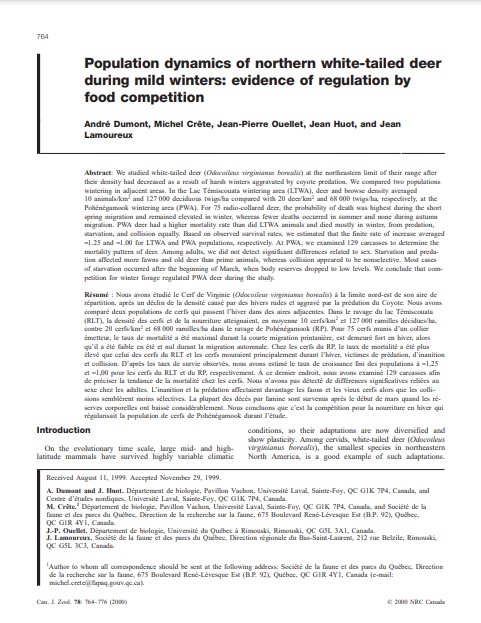Population dynamics of northern white-tailed deer during mild winters: Evidence of regulation by food competition
Bosque Modelo:
Bas-Saint-Laurent
Temática:
Gestión forestal
Tipo de documento:
Artículo científico
Resumen
We studied white-tailed deer (Odocoileus virginianus borealis) at the northeastern limit of their range after their density had decreased as a result of harsh winters aggravated by coyote predation. We compared two populations wintering in adjacent areas. In the Lac Témiscouata wintering area (LTWA), deer and browse density averaged 10 animals/km2 and 127 000 deciduous twigs/ha compared with 20 deer/km2 and 68 000 twigs/ha, respectively, at the Pohénégamook wintering area (PWA). For 75 radio-collared deer, the probability of death was highest during the short spring migration and remained elevated in winter, whereas fewer deaths occurred in summer and none during autumn migration. PWA deer had a higher mortality rate than did LTWA animals and died mostly in winter, from predation, starvation, and collision equally. Based on observed survival rates, we estimated that the finite rate of increase averaged ≈1.25 and ≈1.00 for LTWA and PWA populations, respectively. At PWA, we examined 129 carcasses to determine the mortality pattern of deer. Among adults, we did not detect significant differences related to sex. Starvation and predation affected more fawns and old deer than prime animals, whereas collision appeared to be nonselective. Most cases of starvation occurred after the beginning of March, when body reserves dropped to low levels. We conclude that competition for winter forage regulated PWA deer during the study.
Información Bibliográfica
Autor:
Dumont, A, M Crête, J-P Ouellet, J Huot and J Lamoureux.
Revista:
Canadian Journal of Zoology
Año:
2000
N°:
-
País :
Canadá
Páginas:
764 - 776
Volumen:
78
Idioma:
Ingles
Palabras claves
Model forest, Adaptatation, dynamics, animals





